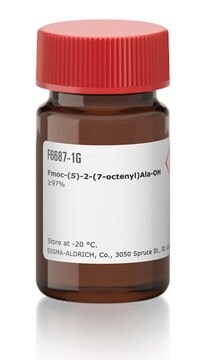F6562
Fmoc-(R)-2-(7-octenyl)Ala-OH
for peptide synthesis
Synonym(s):
(R)-N-Fmoc-α-(7-Octenyl)alanine, Fmoc-(R)-2-(7-octenyl)alanine, Fmoc-(R)-2-amino-2-methyl-dec-6-enoic acid
About This Item
Recommended Products
product name
Fmoc-(R)-2-(7-octenyl)Ala-OH,
form
solid
Quality Level
reaction suitability
reaction type: Fmoc solid-phase peptide synthesis
application(s)
peptide synthesis
functional group
Fmoc
storage temp.
−20°C
SMILES string
O=C(OCC1C(C=CC=C2)=C2C3=C1C=CC=C3)N[C@@](CCCCCCC=C)(C)C(O)=O
InChI
1S/C26H31NO4/c1-3-4-5-6-7-12-17-26(2,24(28)29)27-25(30)31-18-23-21-15-10-8-13-19(21)20-14-9-11-16-22(20)23/h3,8-11,13-16,23H,1,4-7,12,17-18H2,2H3,(H,27,30)(H,28,29)/t26-/m1/s1
InChI key
MADFVGMQNXRFAF-AREMUKBSSA-N
Application
signalword
Warning
hcodes
pcodes
Hazard Classifications
Aquatic Acute 1
Storage Class
11 - Combustible Solids
wgk_germany
WGK 3
flash_point_f
Not applicable
flash_point_c
Not applicable
Choose from one of the most recent versions:
Certificates of Analysis (COA)
Don't see the Right Version?
If you require a particular version, you can look up a specific certificate by the Lot or Batch number.
Already Own This Product?
Find documentation for the products that you have recently purchased in the Document Library.
Our team of scientists has experience in all areas of research including Life Science, Material Science, Chemical Synthesis, Chromatography, Analytical and many others.
Contact Technical Service









